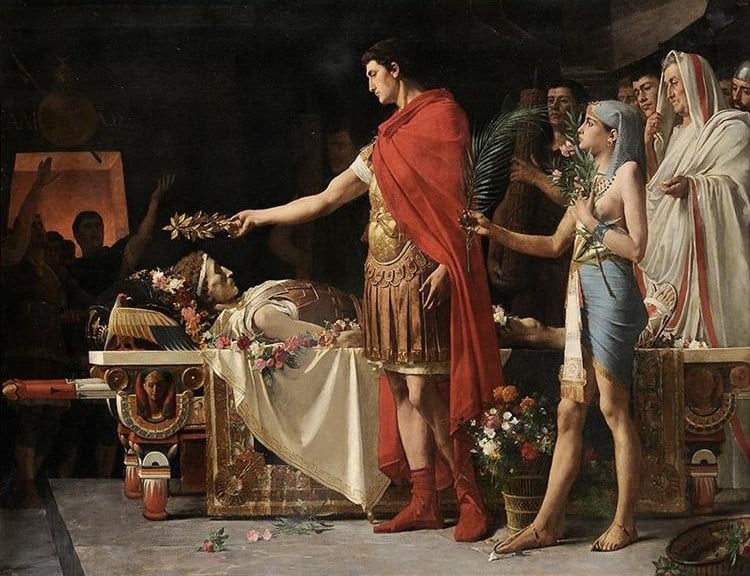
As one of the most famous people in history, countless individuals have tried to locate Alexander the Great’s tomb. It seems shocking that the burial place of such an important figure could be lost, yet that is the case. Various theories exist regarding the location of his tomb, but no consensus has been reached. What do the facts show?
Ancient statements about Alexander the Great’s tomb
The first obvious thing to do when trying to locate Alexander the Great’s tomb is see what ancient texts say about it.
In 323 BCE, Alexander the Great died in Babylon in modern-day Iraq. After building an elaborate gold coffin for him, his men started taking his body back to his home territory in Greece. However, on the way, they were intercepted. Ptolemy I Soter (one of Alexander’s generals) intercepted them and stole the body.
Ptolemy, who was the governor of Egypt at that time, brought Alexander’s body to Memphis. This was the center of the Greek government in Egypt. He had the body buried in that city. However, it did not stay there forever.
According to Greek historians, a few decades later, Alexander’s body was moved to a different location in Egypt. The king was reburied in Alexandria, another important city in the country.
What is the exact location of Alexander’s tomb in Alexandria?

Of course, Alexandria is a big place. Saying that Alexander the Great’s tomb is somewhere in Alexandria is not a very specific claim. Fortunately, the ancient texts can help us be more specific.
Allegedly, Alexander the Great’s tomb was in a mausoleum called the Soma. The problem is that no one knows exactly where the Soma was. According to Strabo, Alexander’s tomb was in the palace district. Scholars know roughly where this was, but this is still a large location. Furthermore, part of this is underwater today. No one can say for sure if Alexander the Great’s tomb is even above water now.
One major problem is that the city of Alexandria does not have a peaceful history. It experienced a number of violent conquests and raids. For example, the city experienced major devastation in 272 CE during the war between Zenobia and Aurelian. Due to this, some scholars believe that the tomb of Alexander the Great was likely destroyed.
Since that time, people have built on top of the previous ruins countless times. Today, the tomb could well be somewhere deep underneath a random street.
The Siwa Oasis
Despite the firm testimony that Alexander the Great’s tomb was in Alexandria, there are some researchers who argue that it is somewhere else. One popular alternative theory is that it is in the Siwa Oasis. This is very far to the west of the center of Egypt close to the Libyan border.
One key reason for this theory is that ancient historians report that Alexander the Great specifically asked to be buried there. Scholars commonly hold that this wish was ignored. But does that necessarily mean that his body was not taken to the Siwa Oasis at some later date?
In any case, one archaeologist claims to have discovered his tomb in the Siwa Oasis. In 1995, archaeologist Liana Souvaltzi announced that she had discovered the tomb. She claimed that the structure she discovered bore signs of a Macedonian identity. There were also some tablets with inscriptions that allegedly supported the idea that Alexander was buried there.
However, other scholars have rejected these claims. Besides rejecting the idea that the design is Macedonian, some have said that there is no clear evidence the structure in question is even a tomb at all.
Was Alexander the Great buried in the Amphipolis Tomb?
Another popular theory is that Alexander the Great was buried in what is now known as the Amphipolis Tomb (also called the Kasta Tomb). This is an enormous tumulus, or grave mound, in northern Greece. It is much larger than any other tumulus ever found in the country.
Significantly, archaeologists have dated this tomb to the last quarter of the fourth century BCE. This is compatible with the time frame of the death of Alexander the Great. The fact that it is so large means that it logically must hold the body of someone important. Due to the size and date, many people initially speculated that this was the tomb of Alexander the Great.
Although there is evidence connecting this tomb to Alexander, it does not necessarily mean that he was actually buried here. A team of archaeologists who excavated the tomb believe that it was dedicated to Hephaestion, a very close friend of Alexander the Great. This is supported by inscription found in the tomb.
Tomb was Taken to Venice
Another notable theory is that Alexander the Great’s tomb is actually in Venice. How would it have gotten there? Well, this theory acknowledges that his tomb originally was in Alexandria. However, that same city was also associated with another famous figure—Mark, the first-century Christian gospel writer.
Documents from the late fourth century CE refer to Mark’s tomb being in Alexandria. This coincides with the last apparently reliable mention of Alexander the Great’s tomb in that city. Something that makes this more interesting is the fact that earlier tradition states that Mark’s body was burned after his execution rather than buried.
In view of this and in view of the fact that the first mention of Mark’s tomb happens to coincide with the last reliable mention of Alexander’s tomb, researcher Andrew Chugg argues that the tombs of Mark and Alexander were one and the same.
In the ninth century, Christians from Venice took “Mark’s” body from Alexandria and had him reinterred in Venice. Today, his supposed body is in Saint Mark’s Basilica. Could this be the tomb of Alexander the Great? Most scholars today do not agree with this theory, but perhaps further research will one day provide further clarification.



